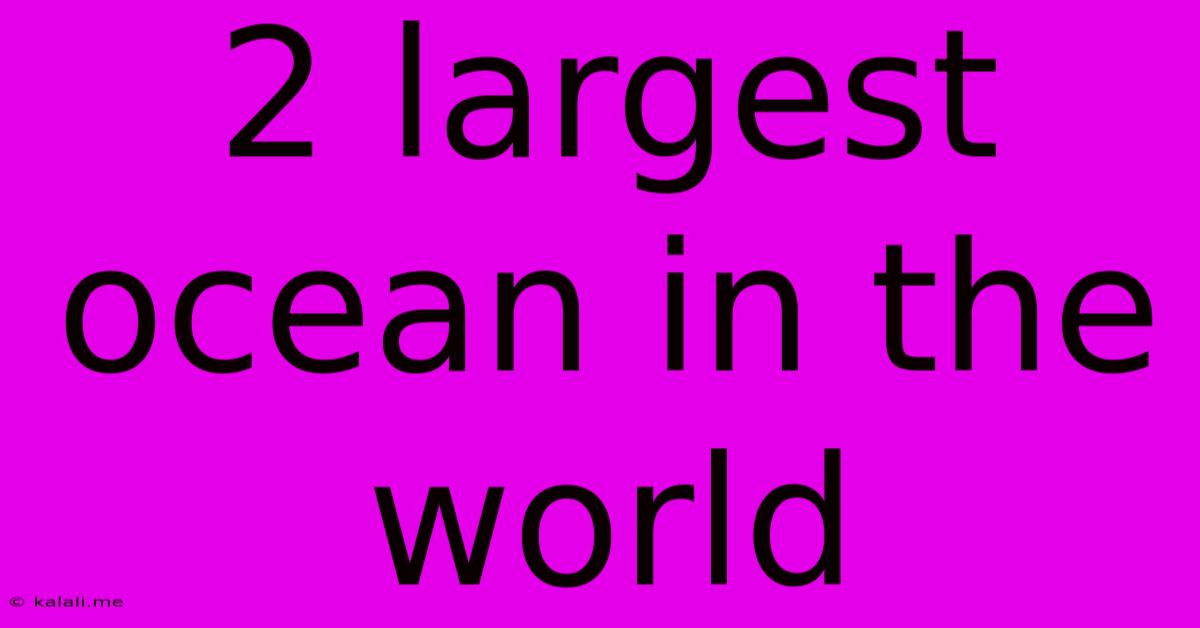2 Largest Ocean In The World
Kalali
Jun 13, 2025 · 3 min read

Table of Contents
Exploring the Two Largest Oceans on Earth: Pacific and Atlantic
The Earth's vast oceans cover over 70% of its surface, playing a critical role in regulating climate, supporting biodiversity, and shaping global ecosystems. While there are five major oceans, the Pacific and Atlantic oceans significantly dwarf the others in terms of size and influence. This article delves into the characteristics, unique features, and ecological importance of these two behemoths of the marine world. Understanding their sheer scale and impact is crucial for appreciating the delicate balance of our planet's environment.
The Pacific Ocean: The Undisputed Champion
The Pacific Ocean, the largest ocean in the world, holds approximately half of the Earth's water. Its immense expanse covers over 63 million square miles (165 million square kilometers), stretching from the Arctic in the north to the icy Antarctic in the south. This colossal body of water boasts incredible depth, with the Mariana Trench holding the record for the deepest point on Earth.
Key Characteristics of the Pacific Ocean:
- Size and Depth: Its sheer size allows for a vast range of climates and ecosystems. The average depth is around 14,000 feet (4,300 meters).
- Geographic Location: It's bordered by five continents – Asia, Australia, North America, South America, and Antarctica – influencing their climates and weather patterns significantly.
- Ring of Fire: The Pacific Ocean is famously home to the "Ring of Fire," a zone of intense seismic activity responsible for frequent earthquakes and volcanic eruptions. This geological activity creates unique underwater landscapes and diverse habitats.
- Biodiversity Hotspot: The Pacific Ocean supports a staggering array of marine life, from microscopic plankton to the largest whales on Earth. Its diverse ecosystems include coral reefs, deep-sea vents, and vast open ocean regions.
- Island Chains: It features numerous island chains and archipelagos, each with unique flora and fauna, showcasing the remarkable biodiversity of this vast ocean.
The Atlantic Ocean: A Close Second
The Atlantic Ocean, the second largest ocean, is significantly smaller than the Pacific but still remarkably vast, covering approximately 41 million square miles (106 million square kilometers). It extends from the Arctic Ocean in the north to the Southern Ocean in the south, separating the continents of Europe and Africa from the Americas.
Key Characteristics of the Atlantic Ocean:
- Transatlantic Currents: The Atlantic Ocean plays a crucial role in global climate regulation through its significant currents, such as the Gulf Stream, which significantly influences weather patterns in Europe and North America.
- Mid-Atlantic Ridge: This underwater mountain range runs almost the entire length of the Atlantic Ocean, a testament to the constant geological processes shaping the ocean floor.
- Diverse Ecosystems: From the cold waters of the Arctic to the warm, tropical regions near the equator, the Atlantic supports a vast array of marine life, including whales, dolphins, fish, and numerous invertebrates.
- Coastal Biodiversity: Its extensive coastlines are home to diverse ecosystems, including estuaries, salt marshes, and mangrove forests, which are critical habitats for many species.
- Economic Significance: The Atlantic Ocean has been historically important for trade and transportation, connecting continents and cultures for centuries. Its resources, including fish and minerals, are also economically significant.
Comparing the Giants: Size and Impact
While both oceans are gigantic and influential, their differences are significant. The Pacific Ocean's sheer size and depth contribute to its incredible biodiversity and unique geological features. The Atlantic Ocean, although smaller, plays a vital role in global climate regulation and has profound historical and economic significance. Both are crucial components of Earth's ecosystem, and their health is essential for the planet's well-being. Protecting these vast oceans is a global responsibility crucial for the future of our planet.
Latest Posts
Latest Posts
-
How Many Molecules Are In 1 Mole Of Water
Jun 14, 2025
-
What Major Element Is Found In Chlorophyll
Jun 14, 2025
-
When The Supply Of A Commodity Exceeds The Demand
Jun 14, 2025
-
Which Of The Following Is Not An Internet Protocol
Jun 14, 2025
-
Which Seismic Wave Type Is Most Damaging
Jun 14, 2025
Related Post
Thank you for visiting our website which covers about 2 Largest Ocean In The World . We hope the information provided has been useful to you. Feel free to contact us if you have any questions or need further assistance. See you next time and don't miss to bookmark.